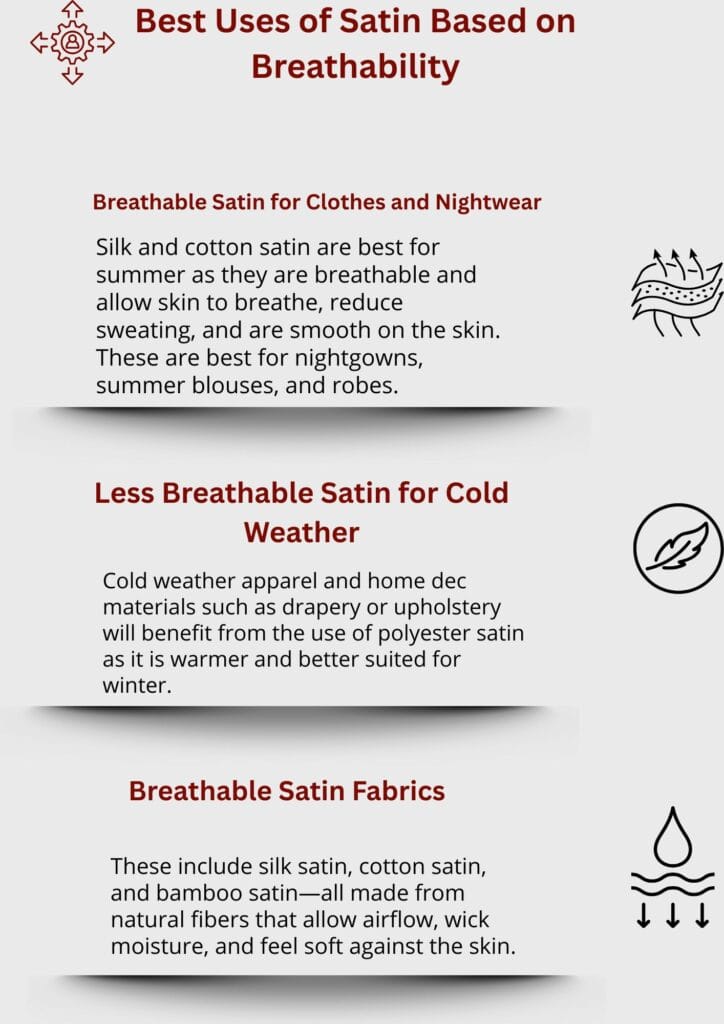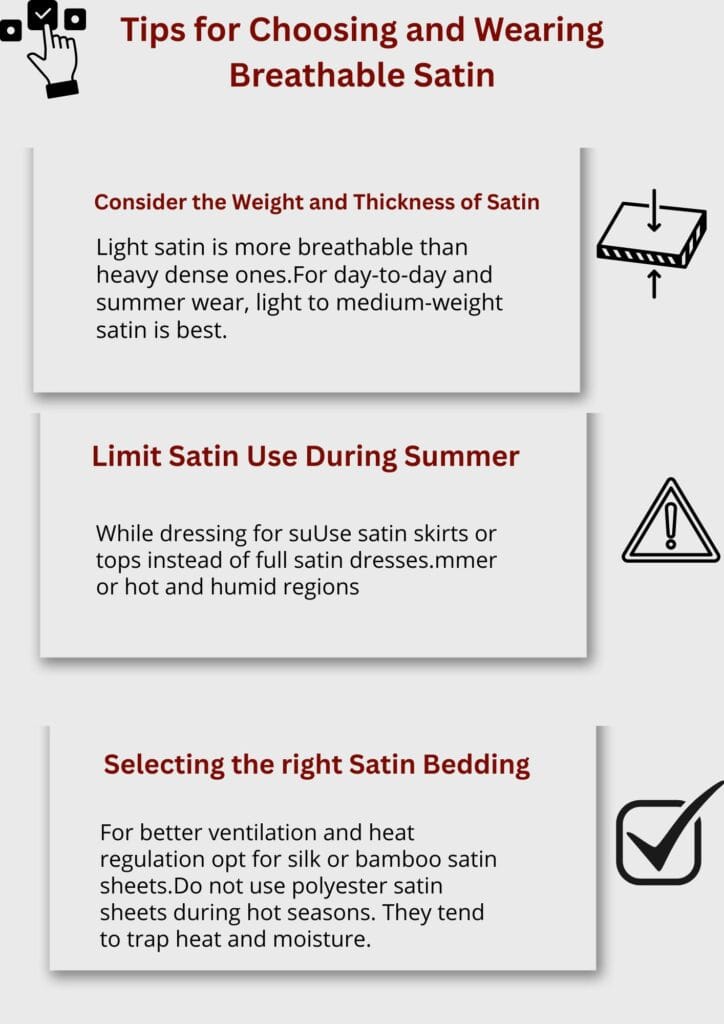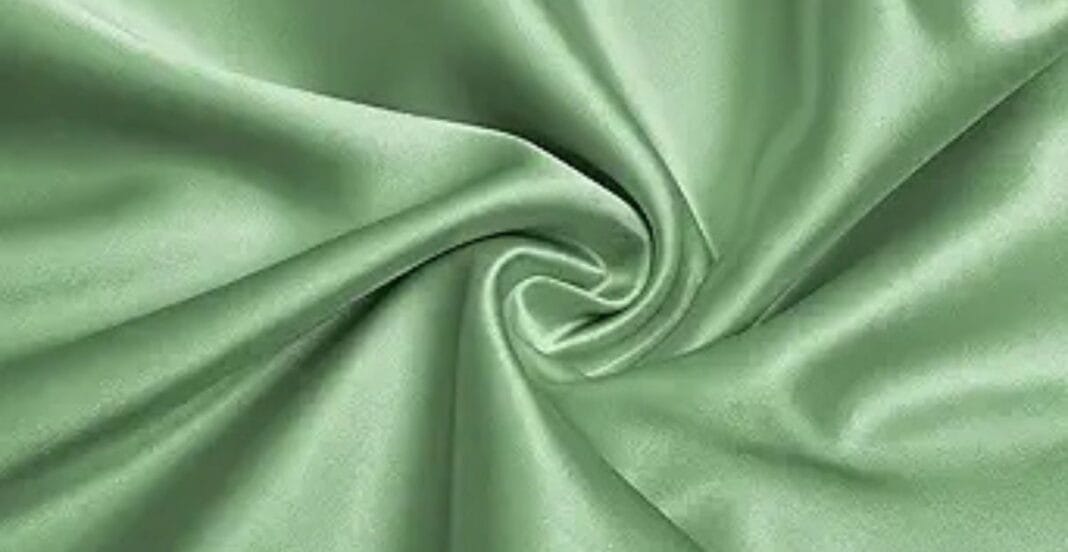Introduction
Satin is not a material, rather, it is a method of weaving. It has a dull underside and glossy surface which gives it its signature look. Various natural and synthetic fibers can be woven into satin. Its distinct feature is the arrangement of threads woven in a way such that light is reflected in a uniform manner.is satin breathable
Common Types of Satin
There are varying types of satin and each type has its own unique texture and level of ventilatation:
- Silk Satin: Considered the most luxurious type, it is made from pure silk and is very breathable.
- Polyester Satin: An alternative made from synthetic fabric. This type is more warm when worn compared with the rest.
- Cotton Satin (Sateen): Softer and more breathable than it’s counterparts, it exhibits a blend of satin and cotton shine.
- Bamboo Satin: A newer addition to satins, uses bamboo fibers to produce a lighter and more eco friendly satin.
All forms of satin have differed feel and different thermal insulating properties.
What Does Breathable Mean In Fabrics?
Breathable means the ability of the fabric to allow air and moisture vapor pass through it. The term ventilated porous fabrics refers to fabrics that allow sweat and moisture passage. Effectively nasal passages are projectile and permeable vapor.
Why Breathability Matters in Clothing & Bedding
Breathability is important for comfort. For clothing, it helps with overheating and sweat issues, while for beds, it allows perspiration to evaporate and moisture to be able to pass through for more restful slumber. Lack of breathability may cause heat rash or dampen sleep quality.
Is Satin Breathable? The Direct Answer
It depends. Breathability is not determined by satin itself, but rather the fiber content, be it silk, polyester, cotton or bamboo, which does matter.
Reasons Why Satin Is Not Breathable
The following satin breathability characteristics are influenced by:
- Fibre: Fabrics woven from silk and cotton are more silky compared to bamboo.
- Tight Weave: Fabrics with tighter weaves tend to be warmer due to restricted airflow.
- Finish Types: Some finishing treatments can seal the surface and reduce moisture escape.
To summarize, satin’s breathability largely depends on
materials used and satin weave used.
Breathability of Different Types of Satin
Now let’s analyze the different satin types regarding their breathability.
Silk Satin – Naturally Breathable and Cooling
Being a natural protein fiber, silk satin has the ability to breathe and wick moisture excellently. Silk satin adapts to your body temperature, making it great for both hot and cold temperatures. Furthermore, its softness and luxuriousness makes it comfortable for sensitive skin.
Polyester Satin – Less Breathable, Traps Heat
Polyester satin is less breathable because it is synthetic. It is a poor fabric because it holds in heat and moisture.Cotton Satin – More Airy Than Other Options
Cotton satin or sateen combines cottons breathability with satins sheen. It is hygienic and absorbs moisture efficiently. Because of these qualities, it is good for regular use as clothing and for bedding.
Bamboo Satin – Light Weight With Environmental Benefits
Bamboo satin is breathable and also helps the environment. It has moisture-wicking abilities as well as ventilating abilities. Its smoothness and anti-bacterial properties make it ideal for hot climates or people with delicate skin.
Satin Vs Other Fabrics In Breathability
How does satin compare with other common fabrics when breathability is the most important?
Satin Vs Cotton
Untreated cotton is more breathable, as is cotton satin (sateen), which merges sheen with airflow. Polyester made satin won’t compare to the cooling effect of cotton.
Satin Vs Linen
Linen is one of the most breathable fabrics available. It surpasses satin in airflow and moisture absorption. Synthetic satin loses to linen in hot weather, as does acrylic and cotton.
Satin Vs Silk
Silk and silk satin are very close in performance. Yet, plain silk may feel more breathable than woven satin. They both excel at temperature regulation.
Satin Vs. Bamboo Fabric
Bamboo and bamboo satin have an edge over polyester satin in satin’s cooling properties and are equal to or better than cotton satin in breathability.
Best Uses of Satin Based on Breathability
Knowing the breathability levels of each satin type enables you to select the most suitable one for your needs.

Breathable Satin for Clothes and Nightwear
Silk and cotton satin are best for summer as they are breathable and allow skin to breathe, reduce sweating, and are smooth on the skin. These are best for nightgowns, summer blouses, and robes.
Less Breathable Satin for Cold Weather
Cold weather apparel and home dec materials such as drapery or upholstery will benefit from the use of polyester satin as it is warmer and better suited for winter.
Most Common Uses of Satin: Where This Luxurious Fabric Shines
One of the most popular fabrics used in the fashion and home industries is satin, mainly due to its smooth surface and glossy sheen. The wide range of satin fabrics—silk, polyester, cotton, and bamboo—means there are multiple fibers to use, in addition, satin is breathability, which is critical when deciding where and how satin should be used. In this article, common uses of satin will be explored in more detail, focusing its features, comfort and performance.
Clothing and Fashion
A satin fabric is widely used in fashion, particularly for elegant attires because of its ease to drape.
- Evening wear and gowns: Since the fabric has flow and shine, its perfect for prom, bridal and formal dresses.
- Blouses and shirts: For stylish and lightweight tops, silk or cotton satin is the go to as they are breathable.
- Lingerie and robes: Nightwear made in silk or bamboo is very silky like to the skin making satin a luxurious choice.
- Jackets and bombers: Stylish outerwear like bomber jackets are often made from polyester satin.
Silk and cotton satin are more breathable fabric types and therefore, more appropriate for warmer climates and everyday use. On the other hand, polyester is a less breathable satin that is more suitable for occasional wear or during colder seasons.
Bedding and Home Textiles
Satin’s smooth texture and luxurious sheen greatly enhance bedrooms and living spaces.
- Bedsheets and pillowcases: gloves and head wraps are made of silk and bamboo satin which are breathable and cooling, making them soft and gentle on the skin and hair.
- Duvet covers: Satin is good for modern furnishings because of its sleek, soft, and texture.
- Curtains and drapes: The use of satin for window treatments gives them added elegance, but these aren’t chosen mostly because they are not breathable.
- Decorative pillows and upholstery: These are often made from polyester satin due to its lower cost and high durability.
In hot weather, silk and bamboo satin are the best natural fiber materials for breathability and comfort to the skin.
Accessories and Footwear
Satin is a soft and stylish fabric used for small elements of fashion.
- Hair accessories: Silk satin is used to make headbands, scrunchies, and bonnets that minimize hair breakage and frizz.
- Handbags and evening clutches: Formal bags are often made from polyester satin as it has a luxurious appearance.
- Shoes: Elegant satin finished bridal and wedding shoes are popular leading to more satin covered heels.
Tips for Choosing and Wearing Breathable Satin

Consider the Weight and Thickness of Satin
- Light satin is more breathable than heavy dense ones.
- For day-to-day and summer wear, light to medium-weight satin is best.
- Do not use heavy satin weaves in warm weather as they become increasingly warmer.
Limit Satin Use During Summer
- While dressing for summer or hot and humid regions:
- Use satin skirts or tops instead of full satin dresses.
- Pair satin with cotton or linen for layering.
- Opt for loose fittings to help ventilation and sweat reduction
Selecting the right Satin Bedding
All satin sheets are not equal, especially during warm nights.
- For better ventilation and heat regulation opt for silk or bamboo satin sheets.
- Do not use polyester satin sheets during hot seasons. They tend to trap heat and moisture.
- For a good night’s sleep, combine satin pillowcases with cotton or bamboo sheet sets.
Conclusion
So, is satin breathable? It entirely depends on the type of satin. Satin made from natural fibers such as silk, cotton, or bamboo satin have good breathability as well as moisture management and comfort. However, polyester satin while looking elegant and being inexpensive, does not work well in warm weather or on sensitive skin because it tends to trap heat and sweat.
The satin selection differs from person to person depending their needs. For summer apparel, sleepwear or lightweight beddings, use silk satin, cotton satin or bamboo satin. Such fabrics enhance airflow, control temperature, and are comfortable to wear during the night. If one is furnishing a room or dressing for cooler seasons, then one can put on Polyester satin without worrying about breathability.


